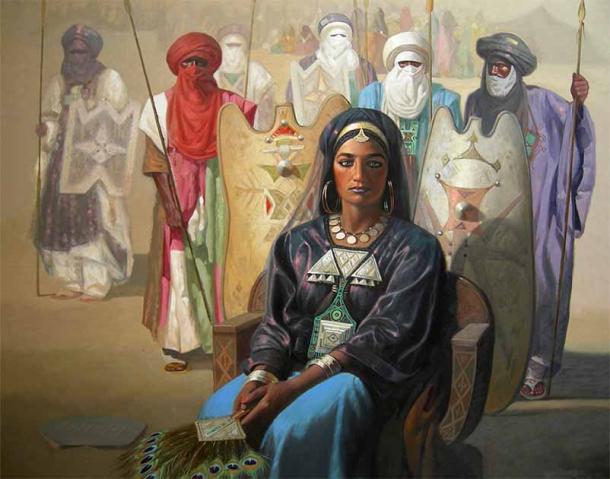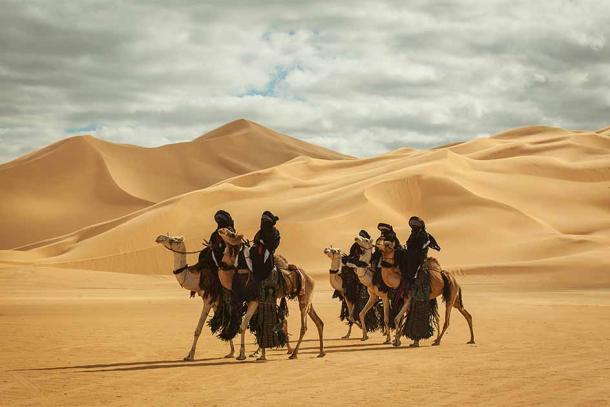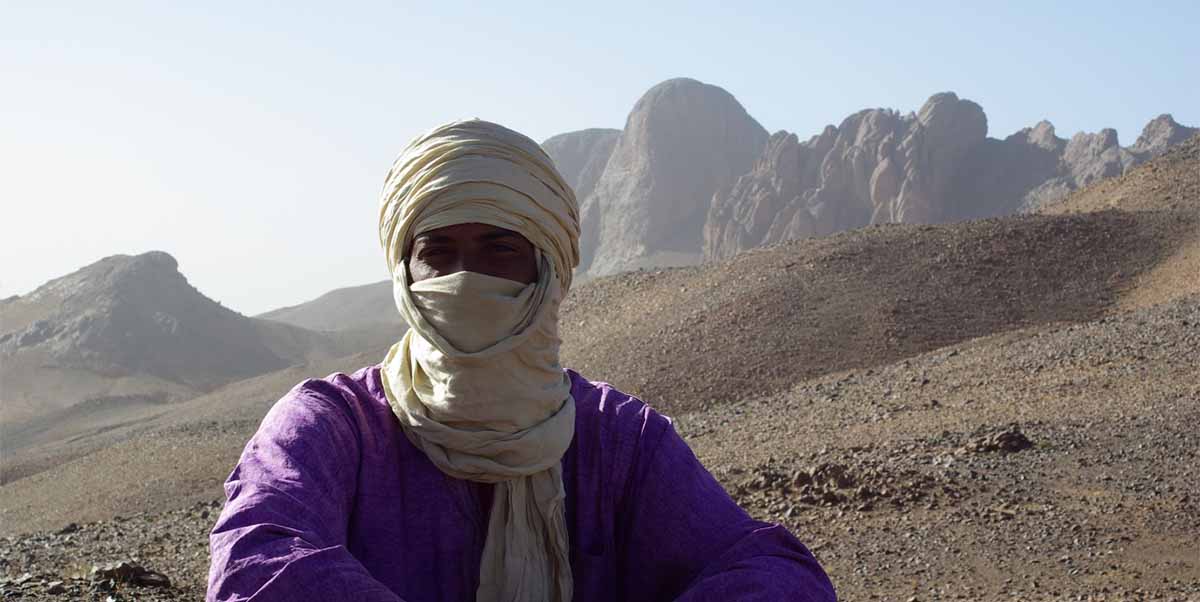The Ancient Tuareg: “Free Men” of the Sahara Desert
In the heart of the Sahara Desert, an ancient people known as the Tuareg have thrived for centuries. The enigmatic history, which can be traced back thousands of years, unfolds as a testament to human endurance.
The Sahara Desert, the world's largest hot desert, blankets extensive regions of North Africa, spanning a colossal 9.4 million square kilometers (3.6 million square miles). Much of the desert receives less than 3 cm (1.18 in) of rain a year, while its rivers—apart from the Nile—are irregular and seasonal, making life extremely harsh for its inhabitants. Yet amongst its inhabitants, the Tuareg call the Sahara Desert home.
Within the vast Sahara, the Tuareg, a seminomadic Islamic people, have left an indelible mark. Revered for their merchant and traveler heritage, their adult men don distinctive tagelmust veils / turbans to protect themselves against the relentless desert and remove them only in the company of close family. Theirs is a matrilineal—though not matriarchal—society. Camel caravans echo their storied past, as does their unique music and art.

The Tuareg—a seminomadic Islamic people within the vast Sahara Desert—live in one of the harshest environments in the world. (CROCOTHERY / Adobe Stock)
The Ancient History of the Tuareg and the Legendary Queen Tin Hinan
According to one source, the word Tuareg has its origins in the Arabic language and means “abandoned by the gods.” Other sources argue, however, that the word is derived from Targa, a city in the southern Libyan region of Fezzan, and that a Tuareg is an inhabitant of that city. The Tuaregs themselves do not particularly like this term, and prefer using the term Imashaghen or Imohag, meaning “free men.”
The 5th century Greek historian Herodotus recorded that during his time, the region of southern Libya was inhabited by a tribe known as the Garamantes. It has been speculated that these were the ancient people from whom the Tuareg could trace their ancestry. According to Tuareg folklore, their tribe’s origins can be traced back to the legendary Queen Tin Hinan and her servant Takamet, believed to have lived during the 3rd or 4th century AD.
- The Monumental Tomb of Queen Tin Hinan, Ancient Ancestress of the Tuaregs
- Ghadames, Libya’s Pearl of the Desert
Queen Tin Hinan is regarded as a matriarchal figure in Tuareg folklore and is considered the mother of the Tuareg people. While her name literally translates to mean “she of the tents,” legend has it that she was a fugitive princess who arrived in the mountainous Hoggar region of southern Algeria on a milk-white camel along with her faithful servant, Takamet. Some versions claim that she settled there and became the first Queen of the Tuaregs.
Tin Hinan has been remembered as a fearless warrior, a literate and knowledgeable healer, and as the founder of the Tuareg Kingdom who established caravan trading routes throughout the Sahara Desert. The children of both Tin Hinan and Takamet are said to be the ancestors of the Tuareg.
In the 1920s, a tomb was discovered near the Abalessa Oasis in Algeria. Although it received far less publicity than the earlier discovery of Tutaankhamun’s tomb, the details of the tomb seemed to reaffirm the existence of their legendary queen. The tomb was comprised of a circular stone structure on a hill which contained the skeleton of a luxuriously adorned woman covered with a red leather cloak and accompanied by funerary objects dating back to the 4th century AD. The site has been used as the location for the Tin Hinan Festival, a cultural event which has paid tribute not just to their queen but also to the role of women in Algerian society.

Artistic representation of Queen Tin Hinan of the Tuaregs by Hocine Ziani. (Public domain)
Tuareg Migration, Trade and the Arrival of Colonization
When the Arabs began their conquest of the Maghreb (Northwest Africa) during the 7th century, the Tuareg began their ongoing and continuous migration southwest. By the 11th century, they had arrived in Niger and were recorded to have even founded the city of Timbuktu. The arrival of the Tuareg placed a great pressure on the indigenous tribes, who were eventually overrun and pushed southwards.
By the 14th century, the Tuareg were converted to the Islamic faith, which has remained their religion ever since. From their new territory, the Tuareg were able to engage in the Trans-Saharan trade, where gold, salt and black slaves passed their cities on their way to the North African coast.
These resources, which would eventually end up in Europe and the Levant, brought them great wealth. By the 19th century, a new power came to North Africa – France. Initially, the French had no interest in colonizing the Saharan territories. Competition with Great Britain and other European powers during the so-called Scramble for Africa in the late 19th and early 20th centuries, however, caused them to extend their colonial rule across Tuareg territory.

A group of Tuareg men in the desert. (Barudi / Adobe Stock)
French rule was not particularly welcome, and the Tuareg despised their colonial policies. These included the exploitation of Tuareg labor and resources, the conscription of the Tuareg as soldiers in the French Army, heavy taxes and attempts to ban certain Tuareg traditions and practices, such as the owning of ancestral slaves and raids carried out on neighboring tribes. As a result of this dissent, the Tuareg began to revolt against the French colonialists in an attempt to regain their independence, though they were unsuccessful.
- Reviving the Music of their Foremothers: A Traditional Tuareg Instrument for Women Makes a Comeback
- The Rich Mythology and Megalithic Culture of the Ancient Berbers, Lords of the Desert
In 1960, the French began granting independence to their West African colonies. As the emerging countries around the Sahara began building their own territories, the Tuareg were left out. Discontented with the fact that they were not allowed autonomous rule, the Tuareg rebelled in 1963, this time against the newly formed country of Mali.
Although the rebellion was crushed by the end of 1964, it was revived again in the 1990s, as the grievances of the Tuareg had not been addressed by the Malian government in the previous decades.
This rebellion was also underway in neighboring Niger, where initial efforts to integrate Tuareg into the new country had gone to waste with a change of regime in 1974. Whilst a peace was negotiated in 1995, it was an uneasy one, and not agreed upon by all Tuareg groups. Conflicts arose again in the 2000s.
Even today, the Tuareg fight for independence continues and a permanent solution remains nowhere in sight. Presently, the Tuareg are considered a minority group. Dispersed across Northern Africa, their population numbers nearly four million, with their largest community situated in Niger.
Top image: Tuareg man with his traditional tagelmust face and head covering in the mountains of Hoggar, Algeria. Source: Sahara Nature / Adobe Stock
By Wu Mingren
References
Bradshaw Foundation. 2011. “The Tuareg of the African Sahara” in Bradshaw Foundation. Available at: http://www.bradshawfoundation.com/tuareg/index.php
Douglas-Bowers, D. 01 February 2013. “The Crisis in Mali: A Historical Perspective on the Tuareg People” in Global Research. Available at. https://www.globalresearch.ca/the-crisis-in-mali-a-historical-perspective-on-the-tuareg-people/5321407
Gwin, P. 2011. “Lost Lords of the Sahara” in National Geographic. Available at: https://www.nationalgeographic.com/magazine/article/sahara-tuareg
Minority Rights. July 2008. “Tuareg” in Minority Rights Group International. Available at: http://www.minorityrights.org/5518/niger/tuareg.html
NMAfA. 2007. “Art of Being Tuareg. Sahara Nomads in a Modern World: Who are the Tuareg?” in Smithsonian National Museum of African Art. Available at: http://africa.si.edu/exhibits/tuareg/who.html
No Name. 30 March 2003. Touaregs. Available at: http://tuaregs.free.fr/tuareg_e/accueil_ns.htm
Ross, R. 24 February 2022. “The Sahara: Earth’s Largest Hot Desert” in Live Science. Available at: http://www.livescience.com/23140-sahara-desert.html


















Comments
Awesome article, but what were they before they were Islamic?
Peace and Love,
Ricky.